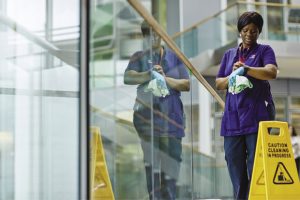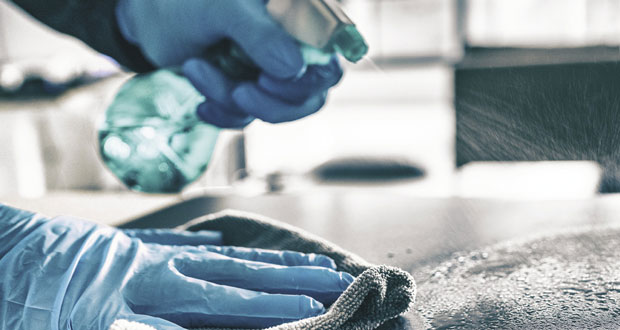The hygiene of premises remains a top priority with building occupants demanding more visible cleaning procedures. FMs are relying on the cleaning sector to help maintain these high performance standards reports FMJ
Visitors and occupants have never been more conscious of the level of hygiene and cleanliness of buildings as they aim to limit their risk of contracting COVID-19. A recent survey commissioned by Pelsis Group found that 87 per cent of people think the hygiene of the places they visit is more important to them than before the start of the pandemic.
The Pelsis survey found that 88 per cent want to see UK businesses and organisations implement stringent hygiene measures, while more than 80 per cent of those surveyed said that the hygiene of the space was very or quite important when visiting communal premises, such as offices, cinemas, restaurants, bars or shopping centres.
Going into the Autumn, more and more people, from office workers to students will be entering buildings in greater numbers than over the previous 18 months, and it will be up to cleaning providers to help maintain stringent hygiene standards.
Says British Cleaning Council (BCC) Chairman Jim Melvin: “In many cases, contractors will either be having or have had conversations with their clients on their roadmap to reopening. Additionally, through both the first and second lockdowns, most clients have been discussing additional requirements in relation to sanitisation and disinfection in areas such as touchpoints, catering and washroom areas.”
The Pelsis Group survey reveals that more than half of those surveyed believed that businesses and organisations could be doing more to keep people safe and improve the hygiene of the premises.
Said David Mills, Category Manager at Pelsis Group: “This goes to illustrate the importance of robust cleaning measures that instil confidence and trust in occupants and members of the public.”
For that reason, argues Lorraine Davis, Mitie’s Director of Cleaning Services continuous improvement is crucial: “We all have a responsibility to continuously review and adapt our cleaning regimes to ensure that as buildings’ occupancy rates change, we can maintain high cleaning standards and keep people safe.
“As no two businesses – or even two buildings are the same – all cleaning providers must start by carrying out a risk assessment to get a clear picture of the sites’ expected occupancy rates, as well as activities or areas which may need additional attention, such as touch point areas, like door handles, stair rails and lift call buttons, which will see increased contact from having more people on-site. Having a clear picture will enable providers to identify the most effective cleaning solutions such as reorganising shifts to ensure surfaces and critical areas are regularly cleaned, using antiviral mists every day or deep cleaning at night.”
MEETING DEMANDS
In the Pelsis Group data, of those who took part in the research, 75 per cent said that being able to check the hygiene protocols of public and commercial premises online and actively see stringent hygiene and cleaning procedures taking place, would make them more likely to visit.
Says Mills: “The survey highlights a very clear message from the public, which is the importance that they place on the hygiene and safety of the premises that they visit, and how they believe businesses and organisations should be doing more.”
According to Davis this will in all likelihood result in customers continuing to request the provision of daytime shifts, at least in the short to middle term to ensure people know their health is being protected and encourage employees back to the workplace.
However, she adds: “This is not to say cleaning during out of office hours is a thing of the past. On the contrary, there are a number of tasks, such as vacuuming or deep cleaning, that can distract employees or cannot simply be done thoroughly while members of the public are on-site. For these activities we will continue to offer a combined approach, with tasks, such as deep cleaning, taking place out of hours and ‘top-up’ cleaning services throughout the day.”
Changes to how cleaning is managed could, explains the BCC have a knock-on effect on how contracts are agreed and how staff are deployed.
Says Melvin:“It is highly likely that contracts will be viewed in a different way and as an example, the daytime regimes are likely to have two differing functions. One will clearly be the cleaning and hygiene of the building, but almost as important will be the perceptive element in creating a confidence for the client’s staff to feel safe. Additionally, we are seeing evidence of additional and continued schedules on touchpoint areas, high traffic areas, catering units and of course washrooms.
“The manner in which teams are deployed may well also change and in the main this will be wholly dependent on building usage, volumes and footfall. It is likely to mean that our staff will be scheduled to be trained and be deployed in different areas with specific tasks based on the listing above.”
DIGITAL SOLUTIONS
Davis reveals that over the last year there has been a significant rise in the number of technology solutions – from sensors that track footfall to help prioritise cleaning, to workplace management apps which provide customers with information on the work carried out across their sites. These were already available before COVID, but the pandemic has sped up their adoption. Davis recommends organisations start by carrying out an assessment of business priorities and then choose the right solutions to meet their needs.
“For instance, for many of our healthcare customers, we’ve deployed digital technologies, such as facilities management apps to quickly locate the nearest Mitie colleagues on-site to help with an issue so, as an example, a spillage can  be mopped up as swiftly as possible. And we’re using the latest in robotics, such as autonomous scrubber-driers to clean floors, too.
be mopped up as swiftly as possible. And we’re using the latest in robotics, such as autonomous scrubber-driers to clean floors, too.
“These solutions have not only freed-up some of our colleagues’ time so that they can focus on disinfecting touch points and critical areas but, with the robots designed to use less water and energy than traditional machines, we’re also helping the NHS achieve its net zero goal.”





